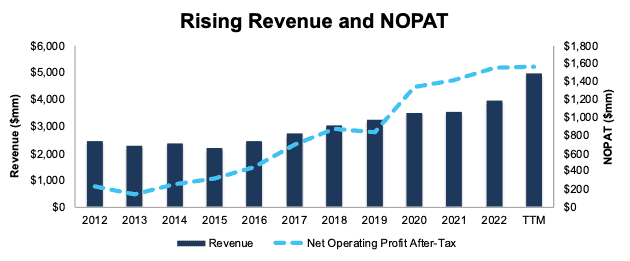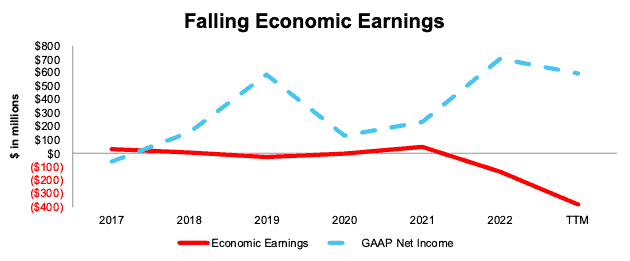17 new stocks made our Most Attractive list this month, while 15 new stocks joined the Most Dangerous list. We published December’s Most Attractive and Most Dangerous stocks to members on December 6, 2023.
November Performance Recap
Our Most Attractive Stocks (+7.4%) outperformed the S&P 500 (+5.8%) last month by 1.6%. The best performing large cap stock gained 18% and the best performing small cap stock was up 18% as well. Overall, 25 out of the 40 Most Attractive stocks outperformed the S&P 500.
Our Most Dangerous Stocks (+11.6%) underperformed the S&P 500 (+5.8%) as a short portfolio last month by 5.8%. The best performing large cap short stock fell by 1% and the best performing small cap short stock fell by 6%. Overall, 10 out of the 34 Most Dangerous stocks outperformed the S&P 500 as shorts.
The Most Attractive/Most Dangerous Model Portfolios underperformed as an equal-weighted long/short portfolio by 4.2%.
This report leverages our cutting-edge Robo-Analyst technology to deliver proven-superior[1] fundamental research and support more cost-effective fulfillment of the fiduciary duty of care.
All of our Most Attractive stocks have high (and rising) return on invested capital (ROIC) and low price to economic book value ratio. Most Dangerous stocks have misleading earnings and long growth appreciation periods implied by their market valuations.
Most Attractive Stocks Feature for November: Zions Bancorporation (ZION)
Zions Bancorporation (ZION: $39/share) is the featured stock from December’s Most Attractive Stocks Model Portfolio.
Zions has grown revenue by 7% compounded annually and net operating profit after tax (NOPAT) by 19% compounded annually since 2012. Zions’ NOPAT margin increased from 10% in 2012 to 32% in the trailing twelve months (TTM), and invested capital turns rose from 0.3 to 0.5 over the same time. Rising NOPAT margins and invested capital turns drive Zions’ return on invested capital (ROIC) from 2% in 2012 to 14% in the TTM.
Figure 1: Zions’ Revenue and NOPAT Since 2012
Sources: New Constructs, LLC and company filings
Zions Is Undervalued
At its current price of $39/share, ZION has a price-to-economic book value (PEBV) ratio of 0.4. This ratio means the market expects Zions’ NOPAT to permanently decline by 60%. This expectation seems overly pessimistic for a company that has grown NOPAT by 15% compounded annually since 2017 and 19% compounded annually since 2012.
Even if Zions’ NOPAT margin falls to 17% (below 5-year average NOPAT margin of 34%) and the company’s revenue grows just 3% (compared to five-year average of 11%) compounded annually through 2032, the stock would be worth $52/share today – a 33% upside. Should Zions grow profits more in line with historical levels, the stock has even more upside.
Critical Details Found in Financial Filings by Our Robo-Analyst Technology
Below are specifics on the adjustments we made based on Robo-Analyst findings in Zions’ 10-Qs and 10-Ks:
Income Statement: we made $117 million in adjustments, with a net effect of removing $94 million in non-operating expense (2% of revenue). Professional members can see all adjustments made to Zions’ income statement on the GAAP Reconciliation tab on the Ratings page on our website.
Balance Sheet: we made $6.9 billion in adjustments to calculate invested capital with a net increase of $4.0 billion. One of the most notable adjustments was $3.1 billion in other comprehensive income. This adjustment represents 46% of reported net assets. Professional members can see all adjustments made to Zions’ balance sheet on the GAAP Reconciliation tab on the Ratings page on our website.
Valuation: we made $663 million in adjustments, all of which decreased shareholder value. The most notable adjustment was $440 million in preferred stock. This adjustment represents 8% of Zions’ market value. Professional members can see all adjustments to Zions’ valuation on the GAAP Reconciliation tab on the Ratings page on our website.
Most Dangerous Stocks Feature: Avient Corp (AVNT)
Avient Corp (AVNT: $36/share) is the featured stock from December’s Most Dangerous Stocks Model Portfolio.
Avient’s NOPAT has fallen from $234 million in 2017 to $66 million over the TTM, or -20% compounded annually. The company’s NOPAT margin has fallen from 7% in 2017 to 3% in the TTM, while invested capital turns fell from 1.2 to 0.4 over the same time. Falling NOPAT margins and invested capital turns drive Avient’s ROIC from 9% in 2017 to 1% over the TTM.
Avient’s economic earnings, the true cash flows of the business which take into account changes to the balance sheet, have fallen from $32 million in 2017 to -$383 million over the TTM. Meanwhile, the company’s GAAP Net Income has risen from -$58 million to $592 million over the same time.
Figure 2: Avient’s Economicvs GAAP Earnings Since 2017
Sources: New Constructs, LLC and company filings
AVNT Provides Poor Risk/Reward
Despite its poor and declining fundamentals, Avient’s stock is priced for significant profit growth, and we believe the stock is overvalued.
To justify its current price of $36/share, Avient must improve its NOPAT margin to 8% (up from 3% over the TTM) and grow revenue by 6% compounded annually through 2032. In this scenario, Avient’s NOPAT would grow 8% compounded annually and equal $505 million in 2032, up from its TTM NOPAT of $66 million. We think these expectations are overly optimistic. For reference, Avient hasn’t generated a margin as high as 8% in the history of the company.
Even if Avient improves its NOPAT margin to 7% (all-time high NOPAT margin) and grows revenue 5% compounded annually through 2032, the stock would be worth no more than $24/share today – a 50% downside to the current stock price.
Each of these scenarios also assumes Avient can grow revenue, NOPAT, and FCF without increasing working capital or fixed assets. This assumption is unlikely but allows us to create best case scenarios that demonstrate the high expectations embedded in the current valuation.
Critical Details Found in Financial Filings by Our Robo-Analyst Technology
Below are specifics on the adjustments we made based on Robo-Analyst findings in Avient’s 10-Qs and 10-K:
Income Statement: we made $924 million in adjustments, with a net effect of removing $483 million in non-operating income (20% of revenue). Professional members can see all adjustments made to Avient’s income statement on the GAAP Reconciliation tab on the Ratings page on our website.
Balance Sheet: we made $2.3 billion in adjustments to calculate invested capital with a net decrease of $620 million. One of the most notable adjustments was $936 million in midyear acquisitions. This adjustment represented 18% of reported net assets. Professional members can see all adjustments made to Avient’s balance sheet on the GAAP Reconciliation tab on the Ratings page on our website.
Valuation: we made $2.7 billion in adjustments to shareholder value with a net decrease of $2.1 billion. The most notable adjustment to shareholder value was $2.1 billion in total debt. This adjustment represents 64% of Avient’s market value. Professional members can see all adjustments to Avient’s valuation on the GAAP Reconciliation tab on the Ratings page on our website.
This article was originally published on December 14, 2023.
Disclosure: David Trainer, Kyle Guske II, Hakan Salt, and Italo Mendonça receive no compensation to write about any specific stock, style, or theme.
Questions on this report or others? Join our Society of Intelligent Investors and connect with us directly.
[1] Our research utilizes our Core Earnings, a more reliable measure of profits, as proven in Core Earnings: New Data & Evidence, written by professors at Harvard Business School (HBS) & MIT Sloan and published in The Journal of Financial Economics.



2 replies to "Featured Stocks in December 2023’s Most Attractive/Most Dangerous Model Portfolios"
Hey, I thought I purchased Most Attractive Stock portfolio when I purchased my subscription. Was I wrong?
Greg Wilsdon
Hi Greg,
Glad you reached out to support@newconstructs.com with this question. I think we got you all sorted out. If not, please reply to that email (or just ping us at support@newconstructs.com). We want to be sure you’re all set.